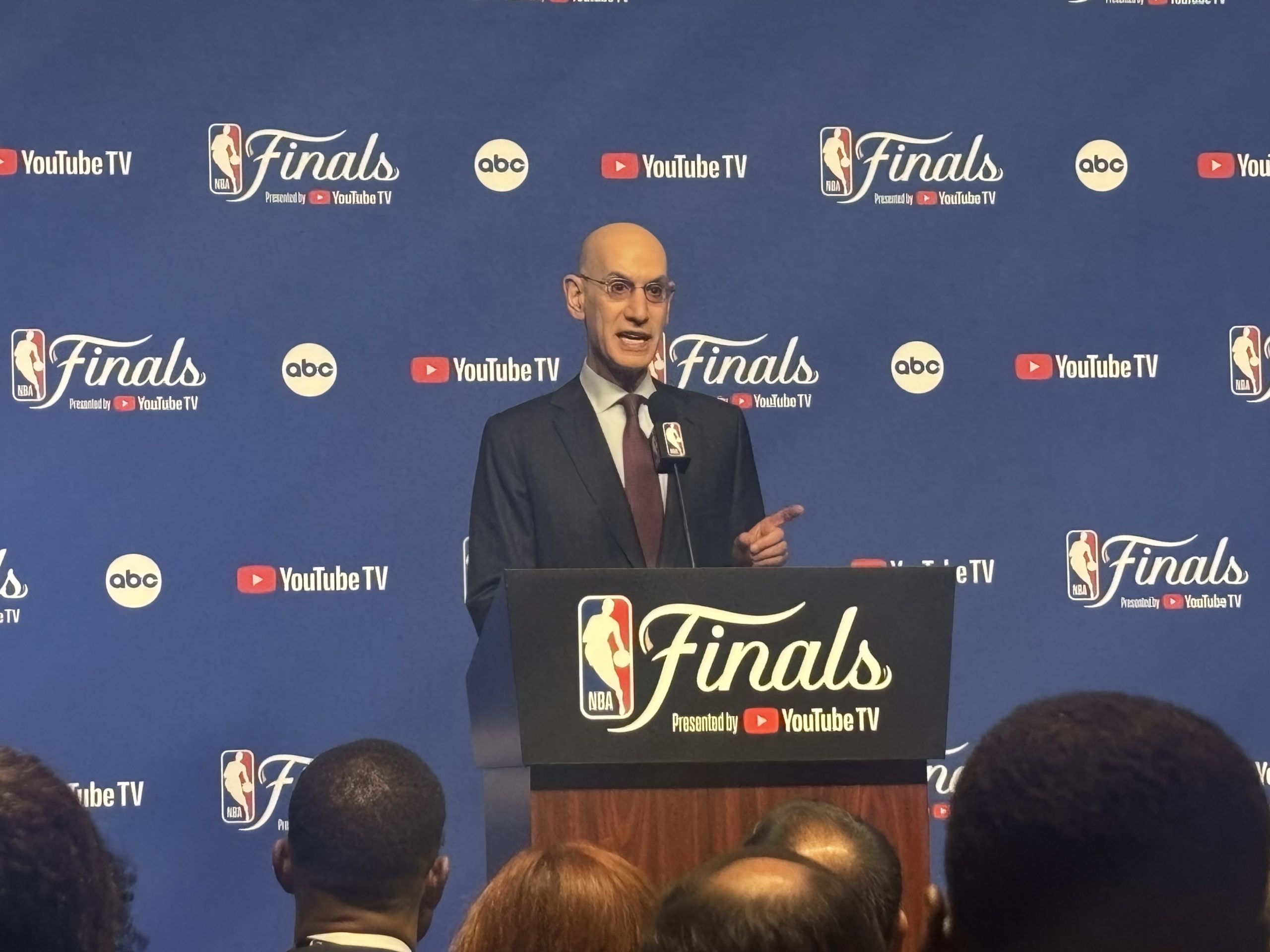
Sports Media Watch is on-site at the 2025 NBA Finals. In Oklahoma City Thursday night, Ben Huddleston attended NBA commissioner Adam Silver’s pregame press conference ahead of Game 1 and presents the following report.
Prior to the start of the 2025 NBA Finals between the Indiana Pacers and the Oklahoma City Thunder, much has been made about the matchup of two small-market teams and its potential to negatively impact the ratings. But as much discussion as is present around the league’s business (compared to the league’s basketball), the NBA is not particularly concerned, as evidenced by commissioner Adam Silver in his pregame press conference Thursday night.
“It seems a little unusual how much discussion there is around ratings in this league,” said Silver, speaking from the interview room deep inside Paycom Center. “Walking on the street, fans coming up to me, it frustrates me that the first thing they say is, how are the ratings? What are the ratings going to be? As opposed to, wow, you have two incredible Conference Finals.”
Silver is probably exaggerating, but the notion that fans’ primary association with this country’s top-flight professional basketball league is television viewership would be problematic, if true.
The discussion of the NBA’s ratings (while, admittedly, fueled in part by this site’s reporting) is particularly ubiquitous compared to other sports. Any observer of sports media knows that football dominates television for half the year. The sport is deeply rooted in the culture of this country, to the point that the survival of the major broadcast networks is at least partially contingent on continuing to air NFL games. But outside of football, the NBA Finals — even a “small-market” Finals — will be among the most-watched sports telecasts of the year, along with the World Series, March Madness tournaments, Kentucky Derby, Indianapolis 500, and other touchstone events in American culture. The NBA’s ratings will clear those of many other sports properties (golf, NASCAR, most NCAA sports, soccer, lacrosse, to name a few) whose ratings are far less scrutinized.
Some of the NBA ratings conversation is driven by bad-faith actors who use the numbers to make wider claims about social issues. As with any inflammatory claim on social media, the provocateurs are yelling all the way to the bank, as culture war-fueled engagement can be very profitable.
The declines of the past few years are real, but often exaggerated and presented without any context. The 2024-25 regular season across national television (ESPN, ABC, TNT, and NBATV) was down five percent from the previous year, in an era of rapidly declining cable subscriptions.
To counter this, the NBA has been proactive. The number of regular season national games available exclusively through a traditional cable package will decrease from 77 this season to zero next season, as NBC, Peacock, and Prime Video join the fold and all of ESPN’s games will be available directly through its new streaming service. It remains to be seen if streaming can produce the same viewership, but early returns from NASCAR seem to suggest it can at least match cable.
Silver noted in his opening remarks that in 2006, the year the Oklahoma City Thunder was purchased from its Seattle ownership, Google purchased YouTube (whose brand presence was inescapable during Thursday’s game telecast) and Twitter and Facebook reached mass markets. The launch of Apple’s iPhone would come the following year. Those technological innovations, Silver noted, “supercharged” the way the NBA’s content could be consumed throughout the world.
The comment gives further insight into the league’s thinking. Television ratings are important, but they’re also not as important as they’re made out to be. The NBA truly views itself as a global business, and a dip in the Finals ratings is not going to change that. Those technological innovations Silver described mean that fans all around the world are consuming NBA content through hundreds of avenues, even if they are not contributing to the Nielsen-measured audience for the games on US linear television.
Is the answer a cop-out? Is Silver spinning the NBA’s social media reach to distract from the smallest-market Finals in league history? Maybe, but the commissioner remains confident in his league as a television property.
“We will be fine because I have no doubt in terms of the value of that content.”
The league may have gotten a boost from Tyrese Haliburton‘s last-second jump shot to give the Pacers their first lead of the game to steal Game 1, turning what many thought to be a five-game affair into a likely six- or seven-game fight. The NBA hopes that that 21-foot pullup, rather than any viewership number, tells the story of this year’s NBA Finals.
